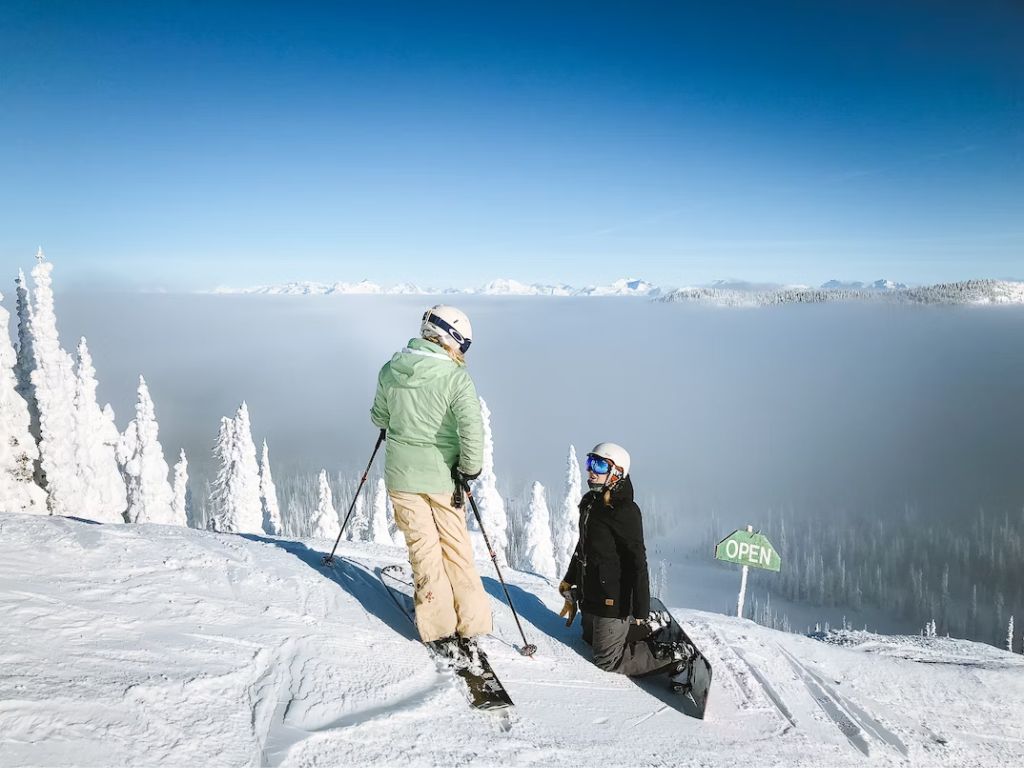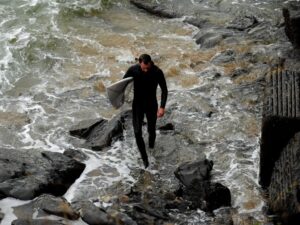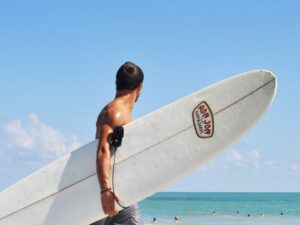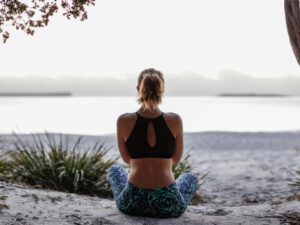As someone who’s been overweight and chiseled as a Greek god at different points in my life, I know a thing or two about pushing limits.
For me, I just hit the gym during my college days. At the time, it never occurred to me that I could just as well have fun while caring for my health. Anyone who has ever gone snowboarding or skiing knows it’s a high-intensity, full-body workout.
But that’s not what we’re asking today, are we? Most of y’all know it’s tiring, but is it an effective workout? Can it replace going to the gym, swimming, or running?
So, let’s shed the goggles (pun intended) and discuss skiing as a potential workout.
Is Skiing a Good Workout?
Skiing is an incredible workout that engages multiple muscle groups, especially your core, legs, and glutes. Skiing demands balance, precision, and endurance with each turn. Because every maneuver forces your muscles to work hard, building strength and burning calories.
As such, skiing is an excellent secondary workout on alternate days. But you’ll still need to find an alternative or go to the gym because skiing doesn’t train your upper body much.
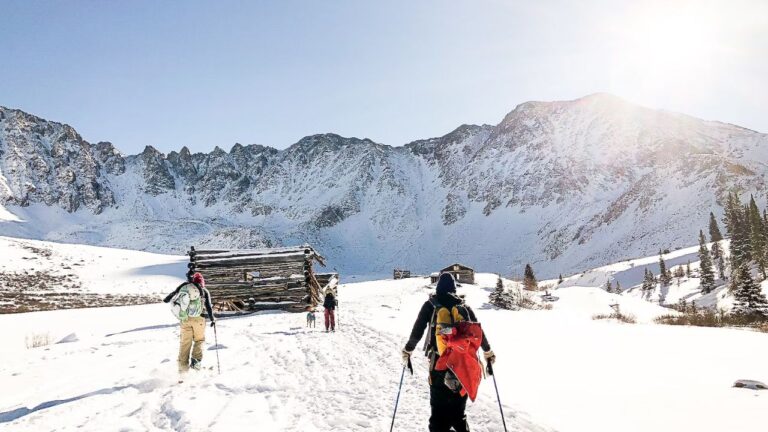
If you love skiing, the ideal routine is skiing 2-3 days a week and hitting the gym for the rest.
1. Which muscle groups does skiing target?
Unlike gym routines focusing on isolated muscles, skiing is a dynamic workout. It targets different muscle groups while you’re gliding down the slope.
Matter of fact, different skiing types (alpine, downhill, cross-country) don’t target the same muscle groups either.
- Quadriceps are your front thigh muscles, tirelessly working as you maintain a bent knee position while skiing. They’re not just holding you up; they’re absorbing the shocks and bumps of the terrain.
- Hamstrings and Glutes act as the balancing counterpart to your quads, providing stability and power, especially when you navigate turns or tackle steeper slopes.
- Core Muscles are not just about having a strong back or tight abs. It’s about creating a stable platform for your limbs to work effectively. The constant adjustments to maintain balance and posture on the slopes are a continuous core workout.
- Arms and Shoulders might seem less active, but these muscles get a fair share of the workout through pole planting and maintaining balance, especially during turns.
2. Is Skiing good cardio?
This probably doesn’t need an explanation if you have ever gone skiing. A good skiing or snowboarding session will get your heart pumping in no time.
The sporadic nature of skiing – bursts of intense effort followed by recovery periods – makes it similar to interval training. And this pattern is excellent for cardiovascular health. The uneven terrain and constant movement challenge your heart and lungs, improving overall endurance and aerobic capacity.
Skiing is literally set up as a HIIT workout.
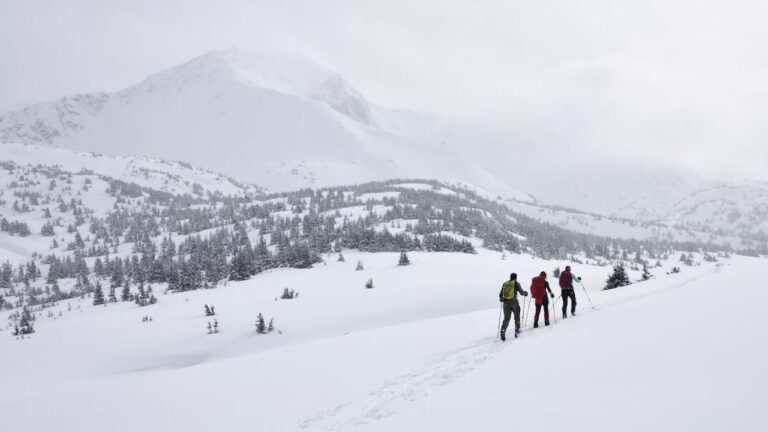
How Many Calories Does Skiing Burn?
When it comes to burning calories, skiing is a powerhouse.
Generally speaking, a person can burn (on average) 400 to 600 calories per hour while downhill skiing. And, if you’re cross-country skiing, the average jumps significantly, often reaching up to 700-900 calories per hour, thanks to the continuous movement and effort required.
Skiing stands out as an effective calorie-burning activity due to its full-body engagement. When skiing, you’re not just using your legs; your core, arms, and balance skills are constantly at work. This total body engagement means you burn more calories than in activities targeting specific muscle groups.
Compared to other aerobic activities, skiing is the most engaging and fulfilling for most people.
Depending on the pace, running can burn about 600-900 calories per hour, while swimming burns around 400-700 calories per hour.
Of course, these numbers vary based on the intensity of the activity and individual factors such as weight and metabolism.
To give a clearer picture, let’s look at a table comparing the average calories burned per hour for three activities – skiing, swimming, and running – based on body weight and height commonly found in the US population.
| Activity | Body Weight (150 lbs) | Body Weight (200 lbs) | Body Weight (250 lbs) |
|---|---|---|---|
| Skiing (Downhill) | 400-600 calories/hr | 500-800 calories/hr | 600-1000 calories/hr |
| Cross-Country Skiing | 600-900 calories/hr | 800-1200 calories/hr | 1000-1500 calories/hr |
| Running (6mph) | 600-700 calories/hr | 800-1000 calories/hr | 1000-1200 calories/hr |
| Swimming (moderate pace) | 400-600 calories/hr | 500-800 calories/hr | 600-900 calories/hr |
1. Does skiing help burn fat?
Skiing is an excellent way to burn fat. It combines cardio with full-body muscle engagement, leading to a high calorie expenditure. The intense bursts in downhill skiing and the prolonged exertion in cross-country skiing increase your heart rate and metabolism, both key factors in burning fat.
Fat burning occurs when you engage in physical activities that increase your heart rate and use more energy than you consume. With its blend of cardiovascular and muscle-engaging movements, skiing ticks these boxes effectively.
How Skiing Contributes to Fat Burning
- High Caloric Burn: As discussed earlier, skiing, particularly cross-country skiing, burns many calories.
- Boosting Metabolism: The intensity of skiing, especially in its varied forms like alpine or cross-country, increases your metabolic rate during the activity and for hours afterward.
- HIIT Nature of Skiing: The sporadic bursts of intense activity followed by recovery periods in downhill skiing mimic High-Intensity Interval Training (HIIT), known for its fat-burning efficiency.
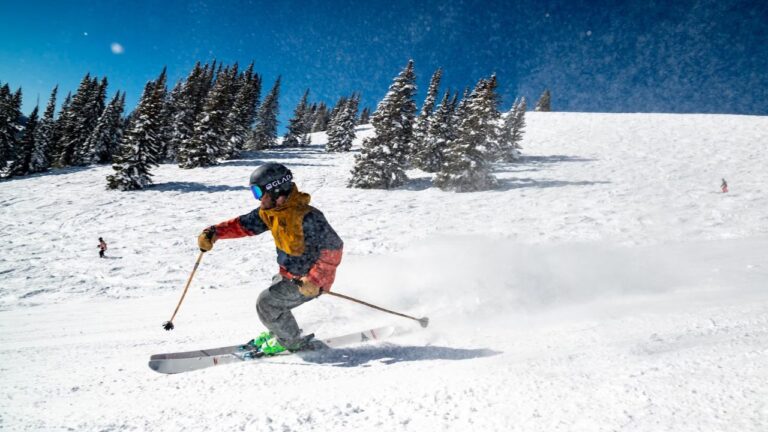
2. Is Skiing good for strength training?
Skiing isn’t ideal for full-body strength training because it primarily targets lower body and core muscles. In skiing, you extensively engage your quadriceps, hamstrings, glutes, and calves as you navigate turns and maintain balance. While it’s effective at building lower body strength, you’ll need an alternative to build your upper body.
Unlike downhill, cross-country skiing involves significant upper body work, engaging the biceps, triceps, and shoulders. However, building your upper body through skiing is insufficient compared to a gym.
For optimal strength training, I recommend you complement skiing with gym workouts. Skiing can handle your lower body and core strength routine, and gym sessions should focus on the upper body and specific muscle isolation.
3. Does skiing help you gain muscle?
Generally speaking, skiing can contribute to muscle gain, particularly in the lower body and core regions. The physical demands of skiing, such as maintaining a bent knee position, navigating turns, and balancing, require continuous engagement and strengthening of your lower body muscles.
This repeated engagement, especially in the context of resistance provided by the slope and snow, can lead to muscle hypertrophy (growth) in these areas.
While skiing is more about endurance and strength than pure muscle gain, regular skiing can contribute to a more toned and muscular lower body and core.
Which Is a Better Skiing Workout, Downhill or Cross-country?
While downhill skiing and cross-country skiing offer exceptional workouts, they target different aspects of fitness and muscle groups.
So, is there a clear winner?
Ideally, cross-country skiing is a better workout than downhill skiing because it’s more engaging, targets more muscle groups, tires you out more, and burns more calories. However, depending on individual needs, you might find downhill skiing a better fit for your body.
To provide a clearer comparison, let’s consider the specific demands and benefits of each type based on my subjective experience:
| Aspect | Downhill Skiing | Cross-Country Skiing |
|---|---|---|
| Primary Focus | Muscle strength, agility | Cardiovascular endurance |
| Muscle Groups | Quadriceps, hamstrings, glutes, core | Quadriceps, hamstrings, glutes, core, arms, shoulders |
| Fitness Type | Anaerobic (strength, power) | Aerobic (endurance, stamina) |
| Calorie Burn | Moderate to high | High to very high |
| Terrain Impact | Varied, with slopes and turns | Mostly flat or rolling terrain |
| Duration | Short, intense runs | Long, sustained periods |
Speaking of muscle groups, I believe that’s the biggest decision-maker between these two.
Muscle Groups Targeted in Downhill Skiing
Downhill skiing primarily focuses on short bursts of intense activity as you navigate slopes. It’s an adrenaline-pumping workout that emphasizes:
- Core & Abdominals: Essential for balance and direction, keeping you upright and responsive to the terrain.
- Lower Body: Skiing engages your entire lower body (quadriceps, hamstrings, glutes, and calves) as you extend your hips and legs or maintain a crouched position and execute turns.
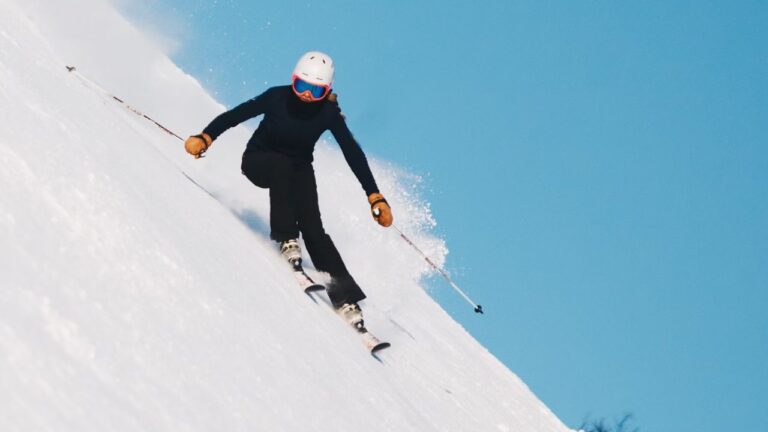
Muscle Groups Targeted in Cross-Country Skiing
On the other hand, cross-country skiing is a test of endurance and cardiovascular fitness. It involves longer periods of sustained effort, providing:
- Obliques & Lats: Cross-country targets the muscles on the side of your stomach (obliques) and the ones on the side of your back (Latissimus Dorsi) when you twist and turn.
- Biceps & Triceps: These muscles in your arms are constantly engaged, given how demanding cross-country terrain is, especially during the double pole technique.
- Pectorals: Pushing your arms forward during cross-country engages your pecs / chest muscles on the front.
- Core & Abdominals: Essential for balance and direction, keeping you upright and responsive to the terrain.
- Lower Body: Skiing engages your entire lower body (quadriceps, hamstrings, glutes, and calves) as you extend your hips and legs or maintain a crouched position and execute turns.
If you aim for muscle strength and enjoy the thrill of navigating slopes, downhill skiing is your go-to. However, if endurance and cardiovascular health are your priorities, cross-country skiing offers unparalleled benefits.
Other Health Benefits of Skiing
Beyond its physical benefits, skiing offers a range of other health advantages that are sometimes overlooked but equally important.
1. Mental Health Benefits
Physical activity like skiing stimulates endorphins, often called ‘feel-good’ hormones. It also enhances your cognitive functions like attention, problem-solving, and memory.
2. Bone and Joint Health
Weight-bearing exercises, such as skiing, strengthen bones and improve bone density, which is crucial for preventing conditions like osteoporosis. Believe it or not, skiing is actually easier on your joints than other extreme sports.
3. Balance and Coordination
It probably needs no explanation but skiing enhances your balance and teaches you better coordination.
4. Social and Emotional Well-being
Skiing is often a social activity, whether you’re hitting the slopes with friends or joining a skiing group. This interaction can improve social skills and contribute to emotional well-being.
5. Sleep Quality
The physical exertion from skiing has statistically shown to improve sleep quality.
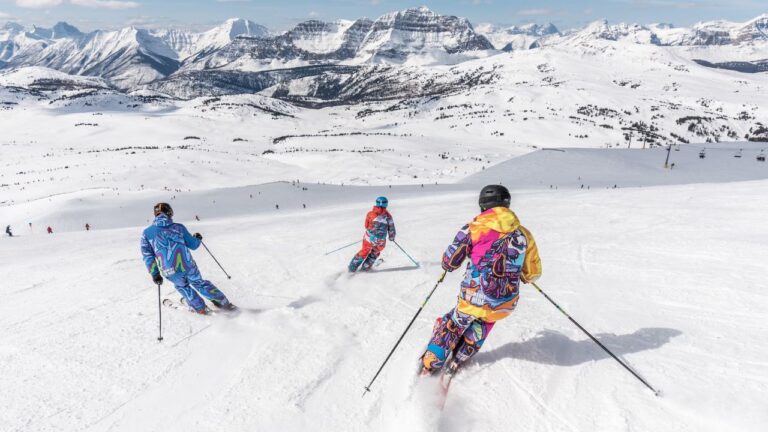
How to Maximize Your Skiing Workout?
1. Pre-Ski Warm Up
Engage in dynamic stretching routines to improve flexibility. This can include yoga or Pilates, focusing on the hips, legs, and back, reducing the risk of injury and enhancing your skiing performance.
2. Proper Technique and Posture
- Body Alignment: Keep your body aligned over your skis. This means your shoulders and hips should be squared and facing downhill. Proper alignment not only improves efficiency but also reduces the risk of injury.
- Knee Position: Keep your knees slightly bent and aligned with your feet. That way, you’ll have better control and shock absorption.
- Pole Usage: Plant your poles firmly and use them to help initiate turns.
3. Ski Equipment
Ensure your ski boots, bindings, and skis are appropriately fitted. Ill-fitting equipment can hinder your performance and increase injury risk.
4. Nutrition and Hydration
A diet rich in carbohydrates, proteins, and healthy fats will provide the energy needed for a day of skiing. I usually take some energy bars in my pocket when I go skiing.
More importantly, skiing can be deceptively exhausting. SO make sure you’re hydrated at all times..
5. Rest and Recovery
Cool down through activities like stretching or a light jog. Consider foam rolling to release muscle tension.
Ensure you’re well-rested before hitting the slopes. Skiing is physically demanding, and fatigue can lead to injury.
Expert QnA
Q. Do I need to be an expert skier to get workout benefits?
Even beginners can enjoy a good physical workout through skiing. As you learn and practice the basics, you engage various muscle groups, improve balance, and enhance cardiovascular health.
Q. Does skiing tone legs?
Skiing is excellent for toning your legs. When skiing, your legs are constantly at work. The repetitive actions of bending your knees, maintaining balance, and maneuvering turns paired with the wild terrain engage and strengthen these muscles, leading to more toned and defined legs.
Q. Can skiing replace a leg day?
Skiing can replace your leg day gym every other week. The movements involved in skiing, such as maintaining a squat-like position, navigating turns, and balancing, work similar muscle groups, including the quadriceps, hamstrings, and calves.
While it does provide a comprehensive lower body workout, skiing doesn’t isolate muscles as specifically targeted gym exercises. Nonetheless, it’s an enjoyable option if you’re looking to mix up your routine and add variety to the boring leg workouts.

